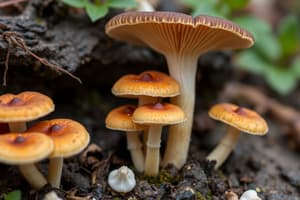Podcast
Questions and Answers
What is the instrument used by scientists to study cells?
What is the instrument used by scientists to study cells?
- Spectrometer
- Microscope (correct)
- Thermometer
- Telescope
What is the function of DNA in controlling cellular activities?
What is the function of DNA in controlling cellular activities?
- Producing energy
- Maintaining cell shape
- Turning genes 'on' or 'off' (correct)
- Regulating temperature
In microscopy, what is the term for the degree of enlargement of an object?
In microscopy, what is the term for the degree of enlargement of an object?
- Refraction
- Magnification (correct)
- Resolution
- Contrast
Which parameter in microscopy determines the clarity and crispness of an image?
Which parameter in microscopy determines the clarity and crispness of an image?
What is the correlation between cell structure and function?
What is the correlation between cell structure and function?
What is the main function of ribosomes in a cell?
What is the main function of ribosomes in a cell?
What is the function of chloroplasts in a cell?
What is the function of chloroplasts in a cell?
Which type of cell lacks a membrane-enclosed nucleus?
Which type of cell lacks a membrane-enclosed nucleus?
What organelle serves as the biosynthetic factory in a cell?
What organelle serves as the biosynthetic factory in a cell?
Which structure is common to both animal and plant cells?
Which structure is common to both animal and plant cells?
What are the four important types of macromolecules mentioned in the text?
What are the four important types of macromolecules mentioned in the text?
What is a polymer?
What is a polymer?
How do monomers form larger molecules in macromolecules?
How do monomers form larger molecules in macromolecules?
Which type of fatty acids have the maximum number of hydrogen atoms and no double bonds?
Which type of fatty acids have the maximum number of hydrogen atoms and no double bonds?
What is the main storage form of glucose in animals?
What is the main storage form of glucose in animals?
Which structural polysaccharide is difficult to digest and found in plant cell walls?
Which structural polysaccharide is difficult to digest and found in plant cell walls?
Phospholipids have a bilayer arrangement found in which cellular structures?
Phospholipids have a bilayer arrangement found in which cellular structures?
Which type of biological molecule does not consist of polymers?
Which type of biological molecule does not consist of polymers?
What type of macromolecule serves as a fuel and building material in living organisms?
What type of macromolecule serves as a fuel and building material in living organisms?
Which type of biological molecule acts as catalysts, speeding up chemical reactions?
Which type of biological molecule acts as catalysts, speeding up chemical reactions?




